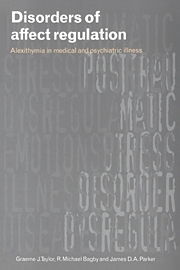Book contents
- Frontmatter
- Contents
- Foreword
- Acknowledgments
- Acknowledgment of permission for use of material
- Introduction
- 1 The development and regulation of affects
- 2 Affect dysregulation and alexithymia
- 3 Measurement and validation of the alexithymia construct
- 4 Relations between alexithymia, personality, and affects
- 5 The neurobiology of emotion, affect regulation, and alexithymia
- 6 Somatoform disorders
- 7 Anxiety and depressive disorders and a note on personality disorders
- 8 Substance use disorders
- 9 Eating disorders
- 10 Affects and alexithymia in medical illness and disease
- 11 Treatment considerations
- 12 Future directions
- Appendix
- References
- Index
6 - Somatoform disorders
Published online by Cambridge University Press: 21 September 2009
- Frontmatter
- Contents
- Foreword
- Acknowledgments
- Acknowledgment of permission for use of material
- Introduction
- 1 The development and regulation of affects
- 2 Affect dysregulation and alexithymia
- 3 Measurement and validation of the alexithymia construct
- 4 Relations between alexithymia, personality, and affects
- 5 The neurobiology of emotion, affect regulation, and alexithymia
- 6 Somatoform disorders
- 7 Anxiety and depressive disorders and a note on personality disorders
- 8 Substance use disorders
- 9 Eating disorders
- 10 Affects and alexithymia in medical illness and disease
- 11 Treatment considerations
- 12 Future directions
- Appendix
- References
- Index
Summary
To demonstrate the clinical usefulness of conceptualizing certain medical and psychiatric illnesses as disorders of affect regulation, we begin with the extremely common but poorly understood problem of patients who seek medical care with persistent somatic symptoms and little or no identifiable disease. Such patients typically present initially to primary care physicians, and are believed to account for as many as 10% to 30% of all visits to family doctors (Kellner, 1990). They are often misunderstood and unnecessarily referred to multiple medical and surgical specialists, which leads to over-investigation and excessive costs to the health care system (Bacon et al., 1994; Bass & Murphy, 1990; Shaw & Creed, 1991; Wickramasekera, 1989). Indeed, their use of inpatient and outpatient services is as much as nine times greater than that of the general population (Smith, Monson & Ray, 1986). When it becomes evident that no adequate medical diagnosis can be made for these patients, the persistent and puzzling somatic symptoms are usually attributed to somatization and described as ‘functional’ with the implication of an underlying psychiatric disorder.
Several studies have shown that many somatizing patients do in fact meet criteria for an anxiety disorder or a major depressive disorder (Bridges & Goldberg, 1985; Kirmayer & Robbins, 1991a); we will discuss this category of somatizing patients in Chapter 7.
- Type
- Chapter
- Information
- Disorders of Affect RegulationAlexithymia in Medical and Psychiatric Illness, pp. 114 - 137Publisher: Cambridge University PressPrint publication year: 1997
- 7
- Cited by



